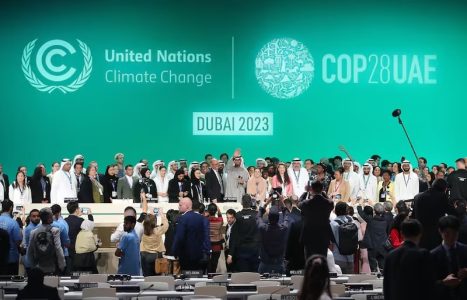The race to go green in “backbone” areas of the economy has made progress despite a mixture of “headwinds and tailwinds” since Cop28 in the UAE, says a chief executive leading the effort.
Green alternatives are increasingly seen as an economic gain and not just a way of tackling climate change, said Faustine Delasalle, who leads an Industrial Transition Accelerator set up at the Dubai summit.
But the large sums of money needed could be held back by high global tensions and the suspense of the US presidential election.
To make the cuts in CO2 emissions by 2030 that scientists say are necessary, the funding for new green industrial plants needs to arrive “in the next couple of years”, Ms Delasalle said.
The Industrial Transition Accelerator, backed by the UAE’s Cop28 presidency, the UN, billionaire Mike Bloomberg and former central banker Mark Carney, was set up to “enable us to do exactly that”, she said.

Its focus is on heavy industries such as steel, cement and chemicals production, as well as air travel and shipping.
Those areas are a “backbone of the global economy” that produce about 30 per cent of the world’s emissions, she said.
Turning them green is tricky because familiar tactics such as replacing fossil fuels with electricity are not as simple in mid-air, at sea and at very high temperatures.
The 197-nation Cop28 climate deal, known as the UAE Consensus, called for these “hard-to-abate sectors” to be a focus of global efforts.
Its focus is on heavy industries such as steel, cement and chemicals production, as well as air travel and shipping.
Those areas are a “backbone of the global economy” that produce about 30 per cent of the world’s emissions, she said.
Turning them green is tricky because familiar tactics such as replacing fossil fuels with electricity are not as simple in mid-air, at sea and at very high temperatures.
The 197-nation Cop28 climate deal, known as the UAE Consensus, called for these “hard-to-abate sectors” to be a focus of global efforts.
As those efforts gather pace “there’s headwinds and there’s tailwinds”, Ms Delasalle, a former French political adviser, told The National.
“There is greater momentum because I think governments understand that this is a matter of climate, but it is also a matter of industrial competitiveness. When it becomes a matter of industrial competitiveness, I think it jumps to the top of the political agenda much faster than when it’s just a climate question.
“On the other hand, we’ve seen increased uncertainty on the political environment in a key number of countries, including the US. We’ve seen greater levels of geopolitical tensions, which obviously creates a more uncertain environment for investment.
“But that wasn’t in the hands of the Cop28 presidency. I think we’re making progress and the Cop28 moment has been an important moment to also frame this as an opportunity for investment and not just a climate imperative.”
Donald Trump’s presidential campaign says he would once again pull the US out of the Paris climate agreement, as he did during his 2017 to 2021 presidency.
Pay a premium
The industry group is heading to the US next month and plans to use the annual New York Climate Week to encourage companies to go green.
It is telling manufacturers they should consider paying a little more for green versions of products such as steel and cement.
Experts hope the cost of clean alternatives, such as making steel and cement with hydrogen fuel, will eventually fall as they become more widespread. But scaling them up relies on people wanting to buy them, in what is sometimes called a chicken-and-egg problem.

“There’s a number of companies that have committed to green purchase at a premium, and we really applaud those. They’re really driving the market and differentiating themselves,” Ms Delasalle said.
“But what we’re seeing is that voluntary demand is insufficient at this stage to drive scale, and so we really need to have an extra nudge towards companies that buy steel, buy cement, buy fertilisers.”
Her advice is that the extra cost will be “diluted” by the time it reaches houses and cars, meaning it should not raise prices too much for the everyday person.
“It shouldn’t be that complex to propose a greener product to the end consumer with a premium that is very small and almost unnoticeable,” she said.
“If you realise that, then I think you can see opportunities to both decarbonise your supply chain and distinguish yourself in the market. But that is something that is not yet at the top of the mind of major consumer good companies.”



